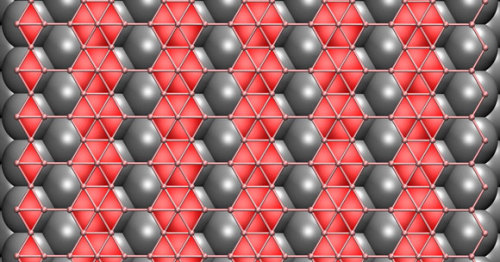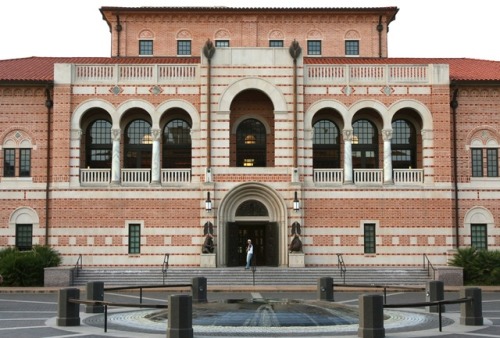#rice university
Light makes Rice U. catalyst more effective: Halas lab details plasmonic effect that allows catalyst to work at lower energy
Rice University nanoscientists have demonstrated a new catalyst that can convert ammonia into hydrogen fuel at ambient pressure using only light energy, mainly due to a plasmonic effect that makes the catalyst more efficient.
[…]
A study from Rice’s Laboratory for Nanophotonics (LANP) in this week’s issue of Science describes the new catalytic nanoparticles, which are made mostly of copper with trace amounts of ruthenium metal. Tests showed the catalyst benefited from a light-induced electronic process that significantly lowered the “activation barrier,” or minimum energy needed, for the ruthenium to break apart ammonia molecules.
The research comes as governments and industry are investing billions of dollars to develop infrastructure and markets for carbon-free liquid ammonia fuel that will not contribute to greenhouse warming. But the researchers say the plasmonic effect could have implications beyond the “ammonia economy.”
Post link
Metal Substrates Shape Two-Dimensional Boron Monolayers
New calculations from theoretical physicists at Rice University show it may be possible to guide the formation of 2-D boron by tailoring boron-metal interactions.
Rice University scientists have theoretically determined that the properties of atom-thick sheets of boron depend on where those atoms land.
Calculation of the atom-by-atom energies involved in creating a sheet of boron revealed that the metal substrate – the surface upon which two-dimensional materials are grown in a chemical vapor deposition (CVD) furnace – would make all the difference.
Theoretical physicist Boris Yakobson and his Rice colleagues found in previous work that CVD is probably the best way to make highly conductive 2-D boron and that gold or silver might be the best substrates.
But their new calculations show it may be possible to guide the formation of 2-D boron by tailoring boron-metal interactions. They discovered that copper, a common substrate in graphene growth, might be best to obtain flat boron, while other metals would guide the resulting material in their unique ways.
Post link
Aluminum “Octopods” – Shape Matters for Light-Activated Nanocatalysts
Study: Pointed tips on aluminum ‘octopods’ increase catalytic reactivity.
Points matter when designing nanoparticles that drive important chemical reactions using the power of light.
Researchers at Rice University’s Laboratory for Nanophotonics (LANP) have long known that a nanoparticle’s shape affects how it interacts with light, and their latest study shows how shape affects a particle’s ability to use light to catalyze important chemical reactions.
In a comparative study, LANP graduate students Lin Yuan and Minhan Lou and their colleagues studied aluminum nanoparticles with identical optical properties but different shapes. The most rounded had 14 sides and 24 blunt points. Another was cube-shaped, with six sides and eight 90-degree corners. The third, which the team dubbed “octopod,” also had six sides, but each of its eight corners ended in a pointed tip.
Post link
New solvent simplifies industrial 3D, roll-to-roll carbon nanotube printing
Carbon nanotubes that are prone to tangle like spaghetti can use a little special sauce to realize their full potential.
Rice University scientists have come up with just the sauce, an acid-based solvent that simplifies carbon nanotube processing in a way that’s easier to scale up for industrial applications.
The Rice lab of Matteo Pasquali reported in Science Advances on its discovery of a unique combination of acids that helps separate nanotubes in a solution and turn them into films, fibers or other materials with excellent electrical and mechanical properties.
The study co-led by graduate alumnus Robert Headrick and graduate student Steven Williams reports the solvent is compatible with conventional manufacturing processes. That should help it find a place in the production of advanced materials for many applications.
Post link
New process aims to strip ammonia from wastewater
A dash of ruthenium atoms on a mesh of copper nanowires could be one step toward a revolution in the global ammonia industry that also helps the environment.
Collaborators at Rice University’s George R. Brown School of Engineering, Arizona State University and Pacific Northwest National Laboratory developed the high-performance catalyst that can, with near 100% efficiency, pull ammonia and solid ammonia—aka fertilizer—from low levels of nitrates that are widespread in industrial wastewater and polluted groundwater.
A study led by Rice chemical and biomolecular engineer Haotian Wang shows the process converts nitrate levels of 2,000 parts per million into ammonia, followed by an efficient gas stripping process for ammonia product collection. The remaining nitrogen contents after these treatments can be brought down to “drinkable” levels as defined by the World Health Organization.
“We fulfilled a complete water denitrification process,” said graduate student Feng-Yang Chen. “With further water treatment on other contaminants, we can potentially turn industrial wastewater back to drinking water.”
Post link
The opening scene for The Astronot film featuring President John F Kennedy’s historic 1962 Speech at Rice University in which the goal was stated to land a man on the moon & return him safely by the end of the decade. The independent film by director Tim Cash & screenwriter @pennanbrae streams on Prime Video via the below link.







Took a photo walk through the Rice U campus with a 60 year old camera. Zeiss Ikon Contessa LK, Fomapan 100. Processed in Ilford DDX.
Literature, Rice University
Daniel Defoe, China and the British Empire






